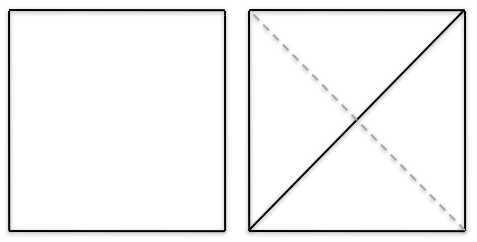UG_IO
SimSys 3D Input/Output Grid Files
Input grids for all UG related
routines, such as AFLR3, assume a consistent ordering of the connectivity.
Input grids for AFLR3 use the optional reconnection flag, grid boundary
condition, and initial normal spacing data if it is included. Output grids from
AFLR3 usually include volume element connectivity and typically don't contain
any of the optional surface grid information.
SURFACE GRID CONNECTIVITY
The node indices for the
boundary face connectivity must be numbered one through Number_of_Nodes. For
AFLR3, all boundary surface faces on a closed surface should be ordered so that
their normals all point out of or into the surface. This is not required if all
surfaces are simply connected. If they are not and there are areas where more
than two faces share an edge then continuous ordering
must be maintained. Each closed surface may have a different ordering (some may
point out and some in). All nodes must be unique in physical space (a given
coordinate location may not have two or more different node numbers). Also,
each possible node index must correspond to an actual node on the boundary
surface triangulation.
The node connectivity for
boundary surface tria faces is ordered as shown below.

where
inode1 = Surf_Tria_Connectivity[0];
inode2 = Surf_Tria_Connectivity[1];
inode3 = Surf_Tria_Connectivity[2];
Indices for tria faces, itria,
are numbered one through Number_of_Trias. Indices for nodes, inode1,..., are
numbered one through Number_of_Nodes.
The node connectivity for
boundary surface quad faces is ordered as shown below.

where
inode1 = Surf_Quad_Connectivity[0];
inode2 = Surf_Quad_Connectivity[1];
inode3 = Surf_Quad_Connectivity[2];
inode4 = Surf_Quad_Connectivity[3];
Indices for quad faces, iquad,
are numbered one through Number_of_Quads. Indices for nodes, inode1,..., are
numbered one through Number_of_Nodes. Input boundary surface grid quad
faces are typically converted to tria faces.
AFLR3 SURFACE FACE
RECONNECTION FLAG
In AFLR3 the reconnection flag
for each boundary surface tria face controls reconnection of the surface
triangulation during boundary recovery. If the flag is zero
then the face can be reconnected with any of its three neighbors. This allows
reconnection of the face during boundary recovery. If the flag is positive then the face can not be reconnected with one or
more "restricted neighbors" in specified directions. The
"restricted neighbors" are specified as follows.
|
Reconnection Flag |
Restricted Neighbor(s) |
||
|
0 |
|||
|
1 |
itria1 |
||
|
2 |
itria2 |
||
|
3 |
itria1 |
itria2 |
|
|
4 |
itria3 |
||
|
5 |
itria1 |
itria3 |
|
|
6 |
itria2 |
itria3 |
|
|
7 |
itria1 |
itria2 |
itria3 |
For a boundary surface tria
face, itria, that contains nodes inode1, inode2, inode3 and has
neighbors itria1, itria2, itria3 as shown below.

If faces itria and itria3
should not be reconnected with each other than the appropriate flag for
boundary face itria would have a value of four. The flag for boundary
face itria4 does not have to be set. AFLR3 will reset the reconnection
flag for neighbor faces so each has compatible flags. Priority is always given
to restricting reconnection whenever the reconnection flag is reset.
For boundary surface quad faces
the reconnection flag is set by AFLR3. The value obtained from the input file
is ignored. Within AFLR3 all quads are converted to trias and the reconnection
flag is set such that the quad edges are preserved.
In general, reconnection of the
surface grid should be allowed wherever possible. AFLR3 will reconnect only if necessary for boundary recovery and if the resulting quality
is within specified limits or better then that of the existing grid. The
resulting volume grids are usually of optimal quality if surface reconnection
is allowed. If part of a surface grid must be connected to another grid with a
prescribed triangulation then limit reconnection only on those faces that must
match up. The default value for the reconnection flag is zero.
AFLR3 SURFACE FACE ID
In AFLR3 the surface ID is used
to group boundary surface faces. It defines a "surface". Boundary
reconnection between faces on different "surfaces" is restricted (the
reconnection flag is automatically set within AFLR3). Surface ID's are also
used with grid boundary condition flag (see grid boundary condition flag
description). And, surface ID's are used to set grid boundary conditions with
the batch/script version of AFLR3.
AFLR3 SURFACE FACE GRID BOUNDARY
CONDITION FLAG
In AFLR3 the grid boundary
condition flag magnitude identifies special types of surfaces. The grid
boundary condition flag is only applicable if boundary-layer or
structured-layer grid generation is selected or if there are embedded or
transparent surfaces. A "surface" is defined as a group of connected
faces with the same boundary id flag. The default value for the grid boundary
condition flag is -1. Note that in some cases multiple values of the grid
boundary condition flag have the same meaning. The possible values and their
implied meaning are listed below.
|
Grid
Boundary Condition |
Description |
|
-6 |
internal
embedded/transparent surface that will be converted to
internal/interior/volume faces with BL volume grid |
|
-5 |
embedded/transparent
surface with BL volume grid |
|
-1 |
standard
surface with BL volume grid |
|
0 |
standard
surface |
|
1 |
standard
surface |
|
2 |
standard
surface that intersects the BL region |
|
3 |
embedded/transparent
surface or source surface that will be converted to source nodes |
|
4 |
embedded/transparent
surface that intersects the BL region |
|
5 |
embedded/transparent
surface |
|
6 |
internal
embedded/transparent surface that will be converted to
internal/interior/volume faces |
|
7 |
fixed
surface that intersects and directly connects to the BL region |
The above descriptions are
applicable only if the boundary-layer or structured- layer grid generation is
selected. If not the following definitions are
applicable.
|
Grid
Boundary Condition |
Description |
|
-6 |
internal
embedded/transparent surface that will be converted to
internal/interior/volume faces |
|
-5 |
embedded/transparent
surface |
|
-1 |
standard
surface |
|
0 |
standard
surface |
|
1 |
standard
surface |
|
2 |
standard
surface |
|
3 |
embedded/transparent
surface or source surface that will be converted to source nodes |
|
4 |
embedded/transparent
surface |
|
5 |
embedded/transparent
surface |
|
6 |
internal
embedded/transparent surface that will be converted to
internal/interior/volume faces |
|
7 |
standard
surface |
Note that embedded/transparent
surfaces that are converted to internal faces will exist within the output
volume grid. They will not be included in the output boundary surface
definition (face connectivity, face ID, etc).
AFLR3 INITIAL NORMAL SPACING
In AFLR3 the initial normal
spacing for boundary-layer elements can be specified as part of an input
surface grid. If it is specified then a value must be
given for every surface node. Only those values for nodes on a boundary face
with a negative grid boundary condition flag will actually be used. The initial
normal spacing is only used if the boundary-layer option is selected. The
default value for the initial normal spacing is zero.
AFLR3 BOUNDARY-LAYER
THICKNESS
In AFLR3 the desired boundary-layer
thickness for boundary-layer elements can be specified as part of an input
surface grid. If it is specified then a value must be
given for every surface node. Only those values for nodes on a boundary face
with a negative grid boundary condition flag will actually be used. The
boundary-layer thickness is only used if the boundary-layer option is selected.
The default value for the boundary-layer thickness is zero.
VOLUME GRID TET ELEMENT
CONNECTIVITY
The node connectivity for tet
elements is ordered as shown below.

where
inode1 =
Vol_Tet_Connectivity[itet][0];
inode2 = Vol_Tet_Connectivity[itet][1];
inode3 = Vol_Tet_Connectivity[itet][2];
inode4 = Vol_Tet_Connectivity[itet][3];
Indices for tet elements, itet,
are numbered one through Number_of_Tets, Indices for nodes, inode1,..., are
numbered one through Number_of_Nodes.
VOLUME GRID FIVE NODE PENT
ELEMENT CONNECTIVITY
The node connectivity for five
node pent elements is ordered as shown below.

where
inode1 =
Vol_Pent5_Connectivity[ipent5][0];
inode2 = Vol_Pent5_Connectivity[ipent5][1];
inode3 = Vol_Pent5_Connectivity[ipent5][2];
inode4 = Vol_Pent5_Connectivity[ipent5][3];
inode5 = Vol_Pent5_Connectivity[ipent5][4];
VOLUME GRID SIX NODE PENT
ELEMENT CONNECTIVITY
The node connectivity for six
node pent elements is ordered as shown below.

where
inode1 =
Vol_Pent6_Connectivity[ipent6][0];
inode2 = Vol_Pent6_Connectivity[ipent6][1];
inode3 = Vol_Pent6_Connectivity[ipent6][2];
inode4 = Vol_Pent6_Connectivity[ipent6][3];
inode5 = Vol_Pent6_Connectivity[ipent6][4];
inode6 = Vol_Pent6_Connectivity[ipent6][5];
Indices for prism (6-noded
pent) elements, ipent6, are numbered one through Number_of_Pents_6,
Indices for nodes, inode1,...,
are numbered one through Number_of_Nodes.
VOLUME GRID HEX ELEMENT
CONNECTIVITY
The node connectivity for hex elements
is ordered as shown below.

where
inode1 =
Vol_Hex_Connectivity[ihex][0];
inode2 = Vol_Hex_Connectivity[ihex][1];
inode3 = Vol_Hex_Connectivity[ihex][2];
inode4 = Vol_Hex_Connectivity[ihex][3];
inode5 = Vol_Hex_Connectivity[ihex][4];
inode6 = Vol_Hex_Connectivity[ihex][5];
inode7 = Vol_Hex_Connectivity[ihex][6];
inode8 = Vol_Hex_Connectivity[ihex][7];
Indices for hex elements, ihex,
are numbered one through Number_of_Hexs, Indices for nodes, inode1,..., are
numbered one through Number_of_Nodes.
SPLIT FACE HEX ELEMENT
CONNECTIVITY
The ICE option (-ice or
m_ice=1) of AFLR3 generates a grid with a Cartesian core of hex elements
that vary in size based on the background mesh and surface mesh. Size
variations between neighboring hex elements is limited to a factor of two.
Neighboring hex elements of varying size produce split faces. Split quad faces
match only at the outermost corner points and have hanging internal edges and
nodes. Additional information is required in order to create a map of element
neighbors. AFLR outputs this information in the form of a SPLIT type data file
for applications that require an element neighbor map. The SPLIT file contains
a list of hex elements that have split faces. The data for each hex element
with a split face includes the hex element index, the split face index (face),
the four non-matching edge-mid-points (inode1, inode2, inode3, inode4),
and the one non-matching face-mid-points (inode5). See the SPLIT file type description for more
information.
The face index varies from 1 to
6 and its ordering is shown below (face1 is 1, face2 is 2, etc.) The node
indicies shown are defined by the hex element connectivity. Each face consist of four nodes. For example, face 2 is made up of
node indicies inode3, inode2, inode6, and inode7.
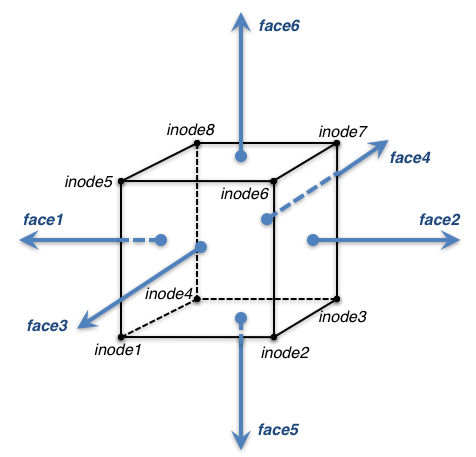
The hanging or non-matching
points are numbered relative to a given face of the hex element. The ordering
of the four edge-mid-points and one face-mid-point along with the four corner
points is shown below. A node index for each of these points is given in the
SPLIT file. If any of them do not exist then the value
given is zero (the corner points always exist).
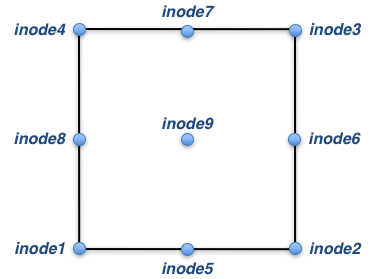
Each split face matches up to
either four quad faces of four neighboring hex elements or three to six tria
faces of three to six tet elements. No other configurations are possible. If
all five mid-points exist then the split face matches
four quad faces as shown below.
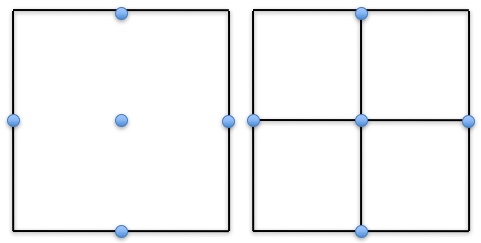
If four mid-points exist then the split face matches to six tria faces as shown
below. Note that the solid line and the dashed line represent the two possible
triangulations of the face.
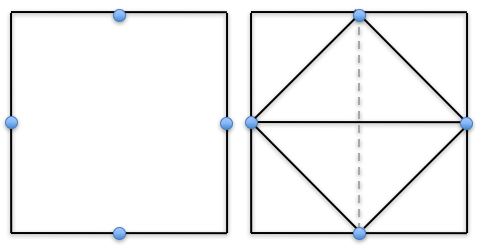
If three mid-points exist then the split face matches to five tria faces as
shown below. Note that the solid line and the dashed line represent the two
possible triangulations of the face. Also, this configuration can be rotated
for four similar configurations.
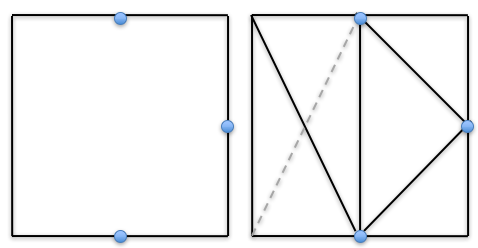
If two mid-points exist then the split face matches to four tria faces in one
of the two configurations shown below. The first configuration can be rotated
for four similar configurations and the second one shown can be rotated for two
similar configurations. Note that the solid line and the dashed line represent
the two possible triangulations of the face.
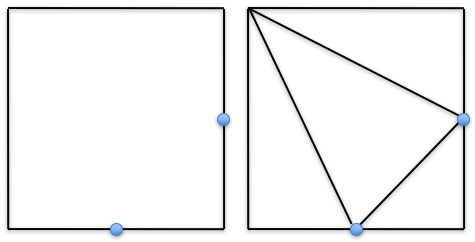 or
or 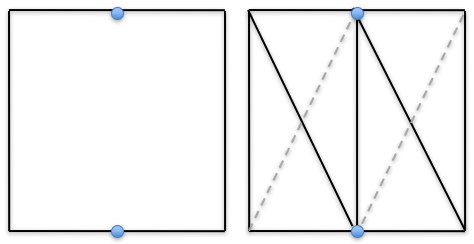
The final possible
configuration is for a single mid-point and it matches to three tria faces as
shown below. This configuration can also be rotated for four similar
configurations.
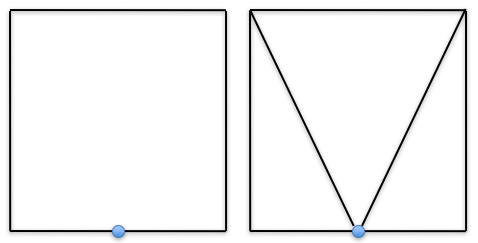
Note that if the hex element is
not split, it still may have a hanging edge. Each non-split face matches up to
either one quad face of the one neighboring hex element or two tria faces of
the two neighboring tet elements. This non-split situation with neighboring tet
elements is shown below. Note that the solid line and the dashed line represent
the two possible triangulations of the face.
